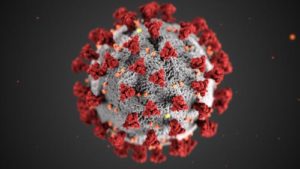Written by Taylor Woosley, Staff Writer. A significant trend toward increased risk of metabolic disorder was observed in the non-recent COVID-19 infected group compared to the serologically negative control group.
 Infection with severe acute respiratory syndrome coronavirus 2 (SARS-CoV-2) is responsible for the coronavirus disease 2019 (COVID-19) pandemic that affected millions of people globally1. The first symptoms of COVID-19 are commonly recognized as fever, dry cough, and shortness of breath2. Although the symptoms of COVID-19 are often not severe, in some cases it can cause more severe complications including end-organ damage3.
Infection with severe acute respiratory syndrome coronavirus 2 (SARS-CoV-2) is responsible for the coronavirus disease 2019 (COVID-19) pandemic that affected millions of people globally1. The first symptoms of COVID-19 are commonly recognized as fever, dry cough, and shortness of breath2. Although the symptoms of COVID-19 are often not severe, in some cases it can cause more severe complications including end-organ damage3.
After the initial acute infection, a multitude of long-lasting symptoms have been described4. Survivors of COVID-19 experiencing persistent symptoms is often referred to as “long COVID” and includes feelings of breathlessness, fatigue, brain fog, and palpitations5. Furthermore, it is well-documented that long COVID is associated with impaired endothelial function which can lead to increased cholesterol and hypertension due to increased vascular oxidative stress and inflammation6.
Deuel et al. conducted a longitudinal cohort study to follow-up on long COVID symptoms in Swiss Armed Forces subjects with a focus on pulmonary, male reproductive, psychological, and general health. Subject inclusion consisted of being between the ages of 18-30 years, who had a positive or negative RT-PCR test for SARS-CoV-2. Participants included in the study were subdivided into four groups: the recent COVID-19 group (≤180 days since positive PCR test), non-recent COVID-19 group (>180 days), control group (serologically negative), or the asymptomatic infection group.
Subjects took a saliva SARS-CoV-2 rapid antigen test to exclude a present infection and completed baseline demographic questions. Further data on fatigue levels, kidney function, C-reactive protein concentration, and lung function was assessed via various scales, blood tests, and spirometry. Additionally, a cardiopulmonary exercise test (CPET) was utilized to assess fitness, heart rate, blood pressure, and CO2 and O2 concentration. Olfactory function, gustatory (taste) performance, ophthalmic examination, and evaluation of psychological and emotional health via self-administered questionnaires were also completed by participants. Male fertility was evaluated using a standard World Health Organization sperm count, with sex hormones also being tested.
Outcome measures included changes in renal, ophthalmological, reproductive, psychological, cardiovascular, and pulmonary health. The Welch two sample t-test or Wilcox test were utilized to compare post-COVID-19 subjects with SARS-CoV-2 negative participants by fitting a generalized linear model. Multivariate analyses were completed for confounding factors by generalized linear modeling. 177 subjects had non-recent COVID-19 infections, 251 participants were serologically negative, 19 had COVID-19 within the last 180 day, and 46 asymptomatically infected subjects were included in the final analysis. Significant findings of the study are as follows:
- A significant trend towards increased risk of metabolic disorders was noted in the non-recent COVID-19 group compared to the control, with higher BMI (p = 0.035), lower aerobic threshold (p = 0.012), higher blood cholesterol (p = 0.0010), and higher LDL concentrations (p = 0.0017).
- Furthermore, the non-recent group experienced more fatigue compared to the control (p = 0.027).
- Subgroup analysis shows relative hyposmia in subjects in the recent COVID-19 group compared to the non-recent group. Additionally, andrology results show poorer progressive motile sperm count in participants in the recent COVID-19 group compared to the control (p = 0.041).
Results of the study show that exposure to COVID-19 may increase the risk of metabolic disorders and also increase anxiety and fatigue. Recent COVID-19 infection was also shown to negatively effect male fertility related to poorer motile sperm count. Study limitations include the small number of female participants and the lack of testing of the omicron variant based on time of testing.
Source: Deuel, Jeremy Werner, Elisa Lauria, Thibault Lovey, Sandrine Zweifel, Mara Isabella Meier, Roland Züst, Nejla Gültekin, Andreas Stettbacher, and Patricia Schlagenhauf. “Persistence, prevalence, and polymorphism of sequelae after COVID-19 in unvaccinated, young adults of the Swiss Armed Forces: a longitudinal, cohort study (LoCoMo).” The Lancet Infectious Diseases 22, no. 12 (2022): 1694-1702.
© 2022 Elsevier Ltd. All rights reserved.
Click here to read the full text study.
Posted July 25, 2023.
Taylor Woosley studied biology at Purdue University before becoming a 2016 graduate of Columbia College Chicago with a major in Writing. She currently resides in Glen Ellyn, IL.
References:
- Montani D, Savale L, Noel N, et al. Post-acute COVID-19 syndrome. Eur Respir Rev. Mar 31 2022;31(163)doi:10.1183/16000617.0185-2021
- Lotfi M, Hamblin MR, Rezaei N. COVID-19: Transmission, prevention, and potential therapeutic opportunities. Clinica chimica acta; international journal of clinical chemistry. Sep 2020;508:254-266. doi:10.1016/j.cca.2020.05.044
- Malik P, Patel K, Pinto C, et al. Post-acute COVID-19 syndrome (PCS) and health-related quality of life (HRQoL)-A systematic review and meta-analysis. J Med Virol. Jan 2022;94(1):253-262. doi:10.1002/jmv.27309
- Lechner-Scott J, Levy M, Hawkes C, Yeh A, Giovannoni G. Long COVID or post COVID-19 syndrome. Multiple sclerosis and related disorders. Oct 2021;55:103268. doi:10.1016/j.msard.2021.103268
- Raman B, Bluemke DA, Lüscher TF, Neubauer S. Long COVID: post-acute sequelae of COVID-19 with a cardiovascular focus. Eur Heart J. Mar 14 2022;43(11):1157-1172. doi:10.1093/eurheartj/ehac031
- Pretorius E, Venter C, Laubscher GJ, et al. Prevalence of symptoms, comorbidities, fibrin amyloid microclots and platelet pathology in individuals with Long COVID/Post-Acute Sequelae of COVID-19 (PASC). Cardiovasc Diabetol. Aug 6 2022;21(1):148. doi:10.1186/s12933-022-01579-5
